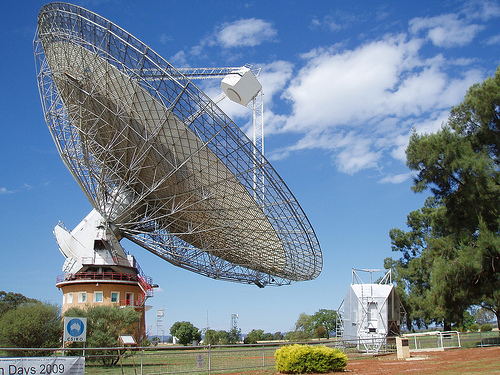theSkyNet launched, set to spread online

Western Australian researchers today switched on a citizen science project dubbed theSkyNet, hoping that it will spread to computers throughout Australia.

Data from CSIRO Parkes Observatory will be used to test theSkyNet.
(CSIRO Parkes Radio Telescope image by Amanda Slater, CC BY-SA 2.0)
Despite the similarity in name between the artificial intelligence software from the Terminator series, theSkyNet has no possibility of becoming self-aware and destroying humanity. Rather, its purpose is to use the combined computing power of personal computers to help analyse and interpret radio signals received from space.
Science and Innovation Minister John Day, who was one of the first to log on to theSkyNet, said that, "by connecting hundreds and thousands of computers together through the internet, it will be possible to simulate a single machine capable of processing signals from space, so they can be used by scientists to support their work".
It is a similar concept to the US-based Search for Extraterrestrial Intelligence project, which uses radio telescopes to listen for radio signals from space, and uses home users' computers to analyse the data collected. However, unlike SETI, theSkyNet is not the primary way that data will be analysed.
Supercomputers, such as the Pawsey Supercomputing Centre in Perth, will take the brunt of the work. theSkyNet will be used to complement the supercomputers' processing power, and also to allow those with an interest in radio astronomy and science to participate. The project also aims to raise the profile of radio astronomy.
The first task that theSkyNet will undertake will be the analysis of data from the CSIRO Parkes Observatory. While the data has already been processed by others before, it will allow researchers to confirm the accuracy and reliability of theSkyNet.
In order to participate, users download open-source software developed by the CSIRO. It runs inside a Java sandbox, prohibiting access to any personal information, and, after analysing downloaded data, uploads the results to theSkyNet's servers, hosted by Curtin University.
The software has been designed to process data at a rate that won't noticeably affect the performance of the machine it's running on, but to encourage uptake there are also leader boards on theSkyNet's website that show how much an individual, or a group of users, have contributed. The top achievers will be eligible to win a trip to Western Australia to visit the Murchison Radio-astronomy Observatory.
The data for the project will come from several sources, including the Australian Square Kilometre Array Pathfinder (ASKAP), a precursor to the $2 billion Square Kilometre Array, which is currently in the final stages of site selection. Southern Africa and Australia are the two shortlisted locations to be the main hub for the final array.
The project theSkyNet is a result of collaboration between the International Centre for Radio Astronomy Research (a joint venture of Curtin University and The University of Western Australia) and UK-based eMedia Track, with support from Western Australia's Department of Commerce and Systemic, a Perth-based IT company.